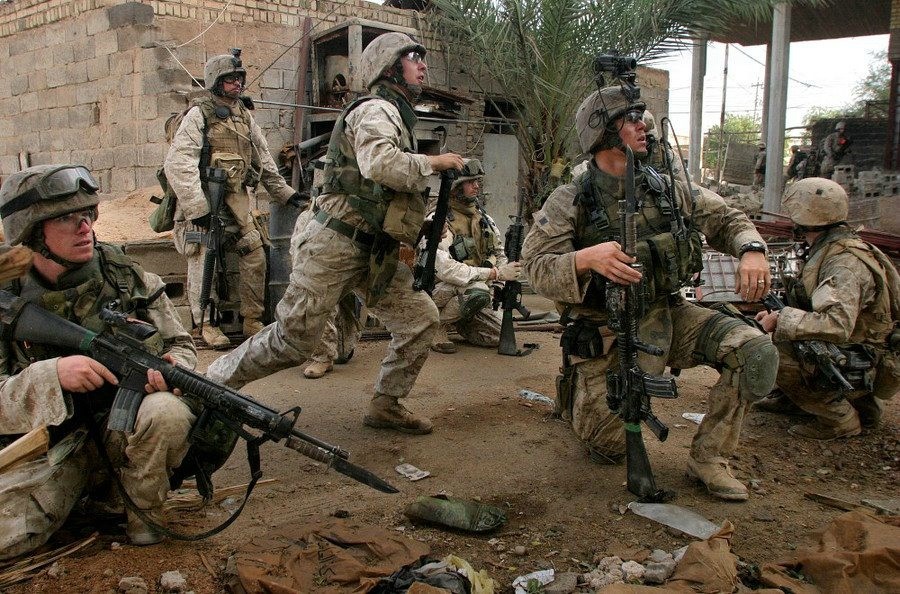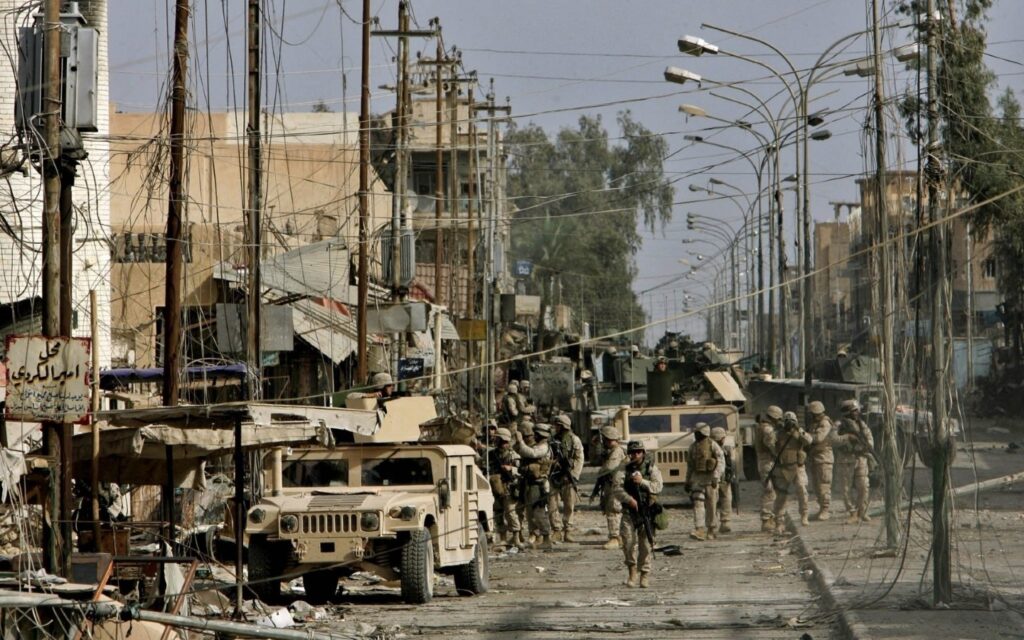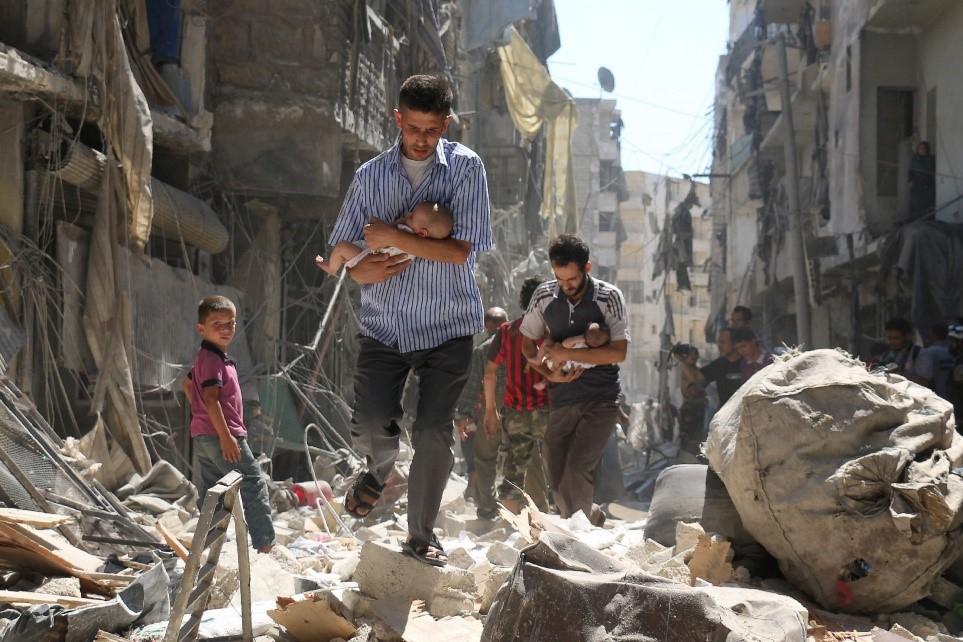On March 31, 2004, a private contractor’s convoy was traveling through Fallujah when it was ambushed by heavily armed insurgents. Safeguarding the convoy were four Blackwater USA employees – Scott Helvenston, Jerry Zovko, Wesley Batalona, and Michael Teague. The four were killed by machine gunfire and a grenade thrown through a window of their SUVs. Their charred bodies were dragged from the burning wreckage of their vehicles by a mob, mutilated, dragged through the streets, and two were hung on display from a bridge over the Euphrates river as the crowd celebrated below.
U.S.- Led Operation to Retake Fallujah Begin
The public display of the beaten and burned bodies of the four security contractors triggered worldwide outrage. In response to the gruesome slaughter of the private security guards, a U.S.-led operation to retake Fallujah began on April 4, 2004 – only four days after the macabre incident.

Within a week, a third of the city had been retaken, but due to the considerable destruction of the city and heavy civilian deaths by U.S. airstrikes, the interim Iraqi government pressured the American forces to withdraw from the city on May 1, 2004. The U.S. then turned over military operations to 1,100-man Fallujah Brigade, led by Muhammed Latif, a former Ba’athist general, but when the brigade folded in September, American weapons and equipment fell into the hand of the insurgents, foreign fighters, and criminals. The Marine command vowed to return and establish some semblance of peacefulness in Fallujah.
The U.S. suffered 27 deaths in the campaign; some 200 insurgents were killed and approximate 600 Iraqi civilians; 300 of them believed to be women and children.
By the early fall of 2004, the chief objective of the American campaign was to eliminate burgeoning insurgency in safe havens in advance of Iraq’s first parliamentary elections after the American invasion. The legitimacy of the interim government, and the upcoming elections appeared to hang in the balance. Fallujah, a city of 250,000 less than an hour’s drive from Baghdad, was the mother of all safe havens and was among the cities to be retaken.
This metropolis on the edge of the desert had a well-earned reputation as a home for former Ba’athist party enforcers and other criminal elements. It was a squalid, unattractive place, unfriendly to strangers – a city, writes military historian Bing West, “comprised of two thousand blocks of courtyard walls, tenements, two-story concrete houses, and squalid alleyways. Half-completed houses, garbage heaps, and wrecks of old cars cluttered every neighborhood.”

The Corps couldn’t wait to assault the city and mix it up with a colorful mélange of al Qaeda, freelance Islamist extremists from across the Middle East, and several Sunni militia groups.
The Battle Turned Out to be the Bloodiest Battle of the Iraq War
That chance came in November and December 2004 with the Second Battle of Fallujah – code-named Operation Al-Fajr and Operation Phantom Fury – as part of a joint American, Iraqi, and British offensive. It turned out to be the bloodiest battle of the Iraq War and is notable for being the first major engagement of the war fought solely against insurgents rather than the force of the former Ba’athist Iraqi government, which was toppled in 2003.
Unlike the recent struggle to take the city back from ISIS, the outcome of the fall 2004 encounter was never really in doubt. Superior numbers, training, and an immense advantage in firepower ensured that the Fallujah would fall to the Americans. The critical questions were, how much blood and treasure would it take to wrest the city from the enemy? Would the city have to be destroyed to be saved? And most importantly, would victory in Fallujah reverse the momentum of an insurgency steadily growing in both numbers and intensity across much of the country?

Lt. Gen. John F. Sattler, the top commander of Marines in Iraq, had the luxury of several months to prepare their plan of attack, which proved to be a very successful plan. A preliminary feint from the southwest 24 hours before the main assault would draw off considerable numbers of jihadists from the northern sector of the city, the direction from which the main attack would proceed. A U.S. Army armored brigade had thrown a tight cordon around the entire city, preventing reinforcements or resupplies from reaching the enemy.
Crucially, the Iraqi government and the Americans had managed to persuade/cajole well over 90 percent of the city’s populace to evacuate their homes, so if the American infantry ran into exceedingly tough resistance, they could employ the full range of their lethal supporting arms – Abrams tanks, the steel rain of 105-mm shells from circling C-130 gunships, jet fighter-bombers, and of course, artillery fire – without fear of causing large numbers of civilian casualties.
During this time, it was clear that an assault on the city was imminent and the insurgents prepared a variety of defenses and strong points. The attack on the city was assigned to Lt. Gen. Sattler’s I Marine Expeditionary Force (I MED).
With the city cordoned off, efforts were made to suggest that the Coalition attack would come from the south and southeast as had occurred in April during the Firsts Battle of Fallujah. Instead, I MEF intended to assault the city from the north across its entire breadth. On November 6, Regimental Combat Team 1 (RCT-1), consisting of the 3rd Battalion/1st Marines, 3rd Battalion/5th Marines, and the U.S. Army’s 2nd Battalion/7th Cavalry, moved into position to assault the western half of Fallujah from the north.
They were joined by Regimental Combat Team 7 (RCT-7), made up of the 1st Battalion/8th Marines, 1st Battalion/3rd Marines and the U.S. Army 2nd Battalion/2nd Infantry which would attack the eastern part of the city. These units were joined by Iraqi as well.
With Fallujah sealed, operations began at 7 pm, November 7, when Task Force Wolfpack moved to take objectives on the west bank of the Euphrates River opposite Fallujah. While Iraqi commandoes captured Fallujah General Hospital, Marines secured the two bridges over the river to cut off any enemy retreat from the city.

A similar blocking mission was undertaken by the British Black Watch Regiment south and east of Fallujah.
During the cold, rainy evening of November 8, the northern rim of the city came under a thunderous and sustained bombardment from artillery and warplanes. Hundreds of 155-mm shells and 500-pound high-explosive bombs shook the earth across a three-mile front, obliterating a train station and a large apartment complex on the outskirts of the city.
An eerie silence followed. Suddenly the two Regimental Combat Teams of Marine infantry and Army armored battalions, about 8,000 men in all, crossed a railroad embankment and began to push south into the city proper. Within seconds, the American advance was met with an avalanche of small arms and mortar fire. Over the earsplitting din of simultaneous fire from thousands of weapons, loudspeakers on Marine Humvees blared Wagner’s “Ride of the Valkyries,” and insurgent commanders barked orders in Arabic over their own loudspeakers, ensconced in the minarets of several of the city’s 200 mosques.

Thus, began ten straight days of brutal, close-in fighting to sweep through this labyrinth of a city, north to south, and wrest it from the insurgents’ grasp. The jihadists had spent the better part of half a year constructing bunkers, strong points, and laying out avenues of retreat, and ambush sites. Hundreds of rooms and entire houses had been expertly booby-trapped, and IEDs had been liberally planted in the streets and alleys. Road blocks of Jersey barriers and junk cars designed to funnel the attackers down lethal avenues of approach seemed to be around every other corner. As the insurgents came under fire from the advancing American battalions, they tended to react in one of two ways: they either held their ground and fought to the death, or they rapidly retreated down side streets or into alleys, hoping to lure the Marines and soldiers into prepared kill zones.

Dexter Filkins, a New York Times war correspondent who had covered half a dozen wars and was embedded with a Marine rifle company in Fallujah, described the combat there as “a qualitatively different experience, a leap into a different kind of battle.” He was hardly the only veteran reporter to register that reaction. Filkins himself narrowly escaped death at least once in the fighting and saw several of the men with whom he was embedded die as well.
Later Gen. Sattler recalled the battle “was intense, close, and personal, the likes of which have been experienced by U.S. forces on just a few occasions since the battle of Hue City in the Vietnam War. There were no real front lines, because the insurgents would get behind you constantly.”
On November 9, after 16 straight hours of fighting to take a fortified mosque being used as a command post, men in B Company, 8th Marines, saw a car pull up behind them. Out poured six insurgents wielding rocket-propelled grenades and AK-47s. The Marines sprung in action, killing four in a matter of seconds before the insurgents could get off a single round of fire. The two remaining insurgents dashed for a courtyard, where they were rapidly cornered by several Marines. Suddenly, one of the insurgents pulled a cord on his suicide vest, sending himself and his brother fighter to instant martyrdom. Virtually every infantry company in Fallujah could report at least one such encounter.
Forty-eight hours into the fight, the Marines had advanced methodically through about one-third of the city, and seized the government center, having leveled several hundred enemy strongpoints to rubble with air strikes, tank fire, and armored bulldozers that proved critical in keeping the advance moving. The insurgents were so entrenched that by the end of the fight, the Marines had been forced to level some 10,000 of 50,000 residences – most were rebuilt at American expense.

On the fourth day of the battle, November 12, both Regimental Combat Teams crossed Highway 10, the six-lane, east-west artery that divided the northern half of the city from the grimy industrial southern half. Southern Falluja had been far more heavily fortified than the north. Here the Marines came up against dozens of unyielding defensive pockets and had to fend off a series of suicidal counterattacks that left the streets littered with bloated, stinking corpses. “Almost as soon as the insurgents were dead, the dogs started gnawing on their bones,” recalled a Marine officer. Heavy rains prevented the authorities from burying these bodies for several days.
It sometimes became necessary to slip small units of Marines in behind the enemy-held pockets to clear them out. Marine Capt. Elliot Ackerman’s platoon slipped behind insurgent lines in the middle of the night, and took up residence in a four-story building.
Author Bing West, who was embedded with a company of Marines in the battle, gives this vivid account of what followed in ‘No True Glory’: “At first light, on both sides of their building, insurgents were slipping forward in bands of four and six unaware of the Marines until the M16s opened up, hitting three or four before the others ducked into the surrounding buildings.”
The insurgents scattered for cover, then converged on the platoon. Within minutes the fighting fell into a pattern. The platoon held a stout building with open ground on all sides, which made a frontal assault suicidal. Instead, enemy snipers, RPG teams, and machine-gunners were running from floor to floor and across the roofs of the adjoining buildings looking for angles to shoot down.

The Marines tried to pick out a window or a corner of a building where an insurgent was hiding and smother it with fire. The shooters on both sides were like experienced boxers, jabbing and weaving and never leaving themselves open. The Marines punched mouse holes in the walls and threw up barricades in front of their machine guns, shifting from room to room every ten minutes.
A particularly effective method for reducing stubborn enemy positions within apartment buildings or other large structures was for the American artillery to fire a “shake and bake” mission: First, a battery of cannons fired incendiary white phosphorus smoke rounds into a building to flush the insurgents outside, and then, after a short delay, they bracketed the building with high explosive rounds to kill them as they exited.
After ten days of grinding, close combat, the Americans, supported by two elite Iraqi Army battalions, had captured the city.
The heavy fighting continued for the next several days as Coalition forces went house-to-house eliminating insurgent resistance. The fighting was not as intense as it had been during the clearing phase, but it was still dangerous, exhausting work. More than 20,000 structures were searched and cleared – some as many as three times, as insurgent hangers-on re-infiltrated previously cleared dwellings. If the Marines were forced to withdraw from a house due to heavy fire from inside, they would reduce it to rubble by attaching a patch of C-4 explosive to two propane canisters and throwing them through a window.
How Many Marines Died in the Second Battle of Fallujah?
By the time it was all over on December 23, U.S. forces had uncovered more than 450 weapons caches, three torture chambers, one of which contained a live prisoner who’d had his leg sawed off, and 24 bomb-making factories. According to a log cited in Bing West’s book, one Marine platoon cleared 70 or more buildings a day for more than a week, during which time they engaged in an average of three firefights a day, and killed 60 insurgents.

The outcome for taking Fallujah was 95 Americans killed in action, and 450 seriously wounded. According to a report from Gen. George Casey Jr., commander of all coalition forces in Iraq, of the 8,400 insurgents killed in 2004, 2,175 had fallen in the Second Battle of Fallujah. Unfortunately, hundreds of Islamist insurgents had either left Fallujah before the battle or slipped through the cordon in small groups and went on to join their brothers to spark new uprisings in Mosul, Ramadi, and East Baghdad.
The Second Battle of Fallujah Joins the Ranks of Tarawa
Even though Abu Musab Al-Zarqawi – the mastermind behind hundreds of bombings, kidnappings and video beheadings in Iraq – was not captured during the operation, the battle severely damaged the momentum of the insurgency. Tactics that were developed in the battles of Fallujah were used on larger scales to capture Ramadi and other surrounding areas afterward. After the Second Battle of Fallujah, the insurgents avoided open battles, but the number of attacks on coalition troops began to rise more. Four years after the bitter fighting, the city was turned over to Iraqi Forces and the Iraqi Provincial Authority.
The Second Battle of Fallujah joins the ranks of Tarawa, the Chosin Reservoir, and the Battle for Hue as one of the Marine Corps’ bitter, hard-won triumphs that unfortunately had little strategic impact on the war of which it was a part.
One veteran of the battle, Col. John Toolan, was hardly the only thoughtful officer to question whether the kind of fighting that had gone on in Fallujah was counterproductive in the long run. “What’s the impact on a ten-year-old kid when he goes back and sees his neighborhood destroyed? And what is he going to do when he is 18 years old?”

Hearts and minds are not won by leveling cities, and by late 2004, the American military was finally waking up to the fact that it was in the middle of a protracted insurgency war, and hearts and minds were what it was all about.
Twelve years later, the Marines have left Iraq, the insurgents remain, and the country finds itself deeply mired in civil war. But Fallujah has at last been retaken, and the Islamic State is clearly on the defensive – at least in Iraq. And that’s good news for Iraq, for the United States, and for the American Marines and soldiers who fought the good fight for Fallujah in 2004.
Unfortunately, even today, more than a decade later, much of Iraq and the Middle East is still beset by violence.
Read About Other Battlefield Chronicles
If you enjoyed learning about the Second Battle of Fallujah, we invite you to read about other battlefield chronicles on our blog. You will also find military book reviews, veterans’ service reflections, famous military units and more on the TogetherWeServed.com blog. If you are a veteran, find your military buddies, view historic boot camp photos, build a printable military service plaque, and more on TogetherWeServed.com today.

0 Comments